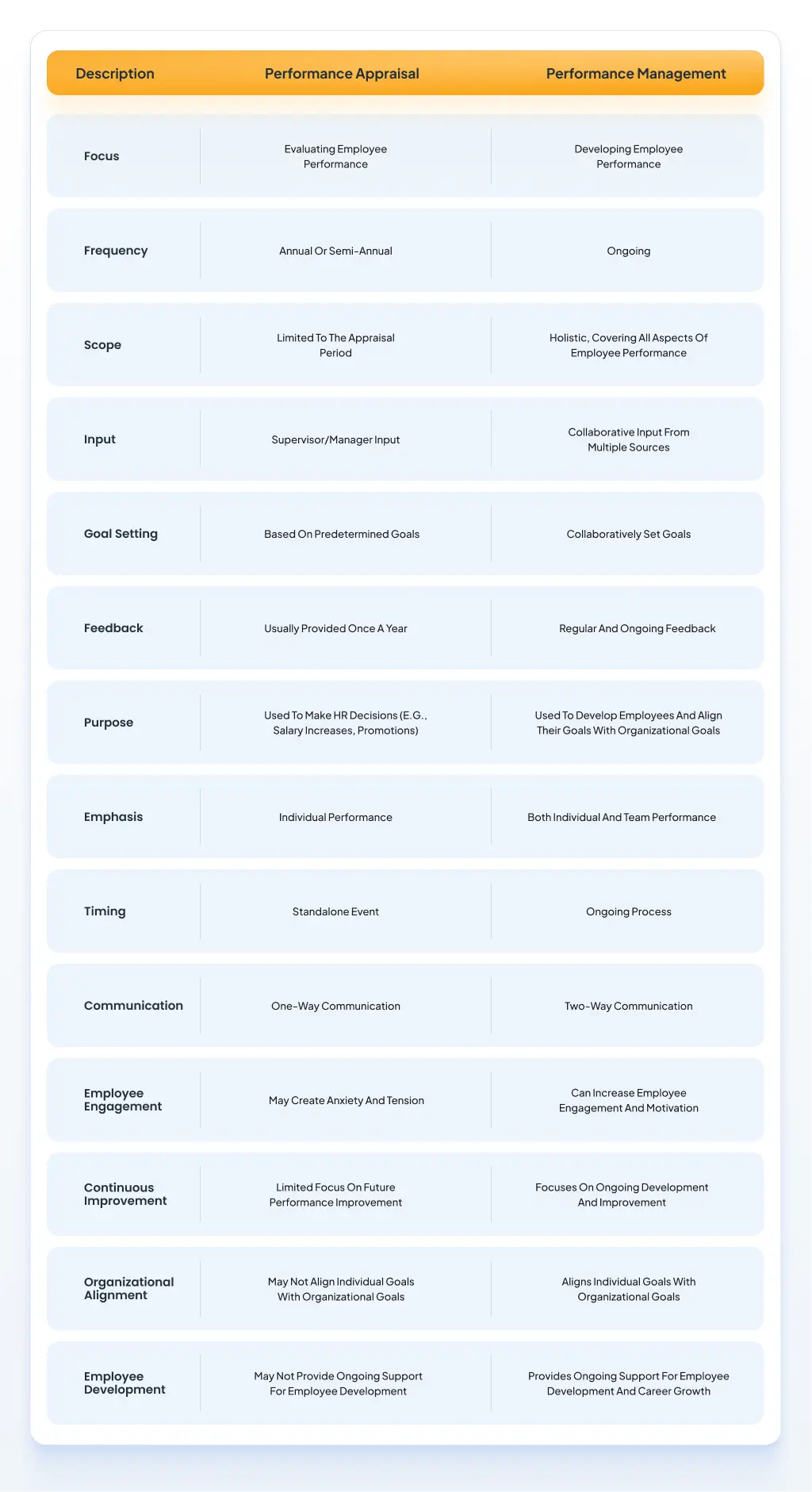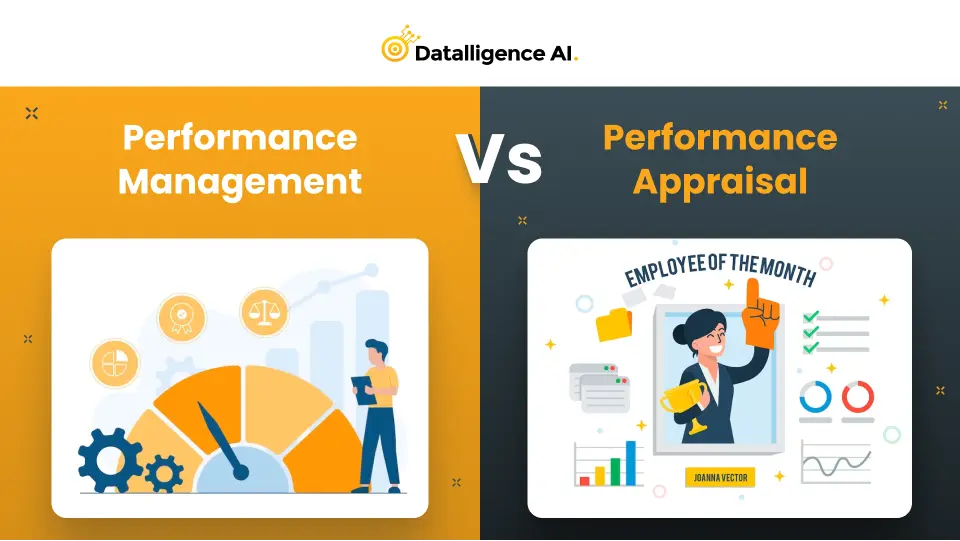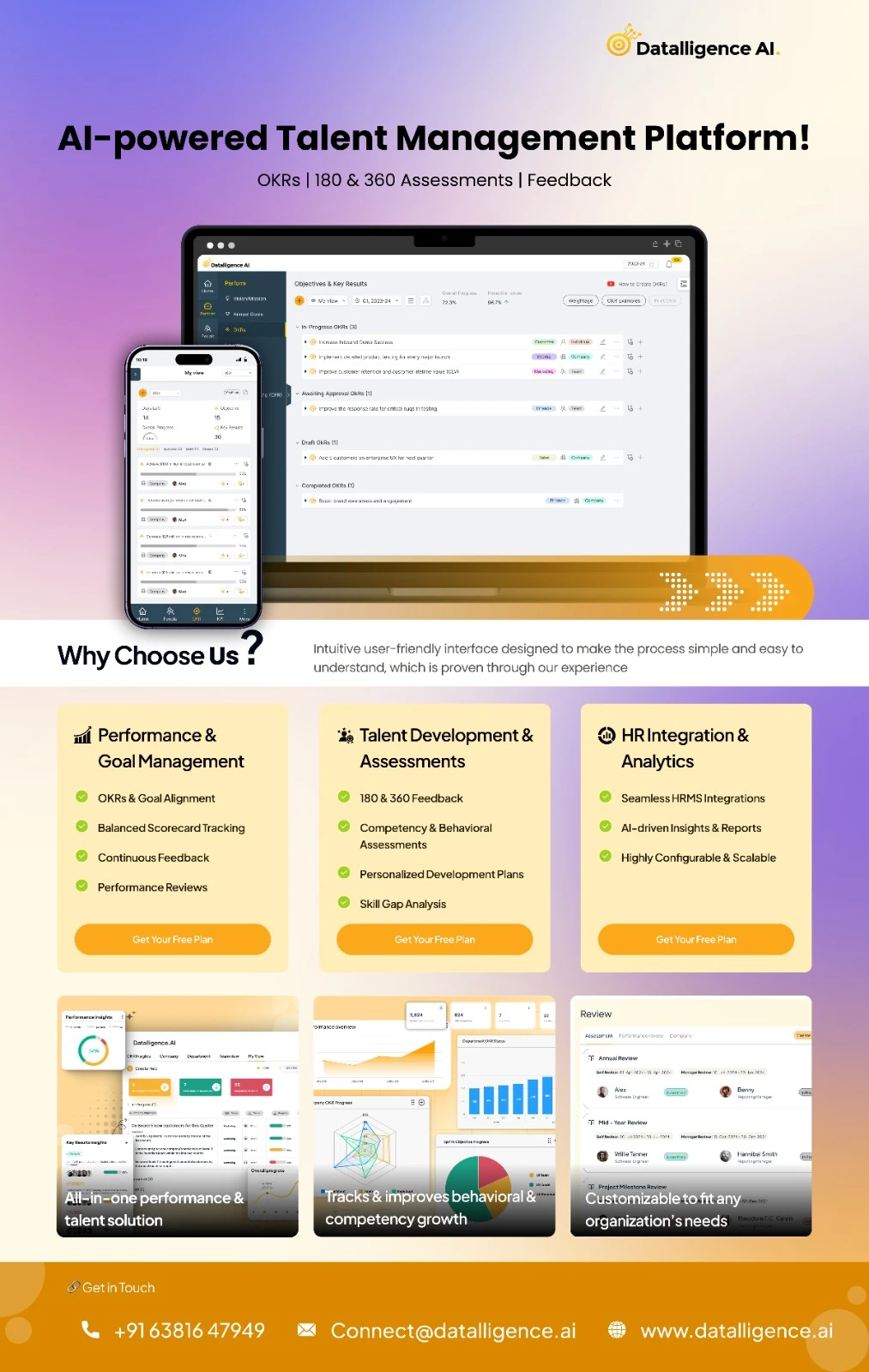Performance management forms the backbone of any high-performing organization. It keeps employees aligned with company goals and supports their continuous growth. By setting clear expectations, regularly monitoring progress, and offering timely feedback, you create an environment where everyone can improve and excel. More than just evaluating performance, effective performance management encourages a culture of continuous learning. It helps employees build on their strengths, address gaps, and unlock their full potential.
Key aspects of performance management include:
- Monitoring and evaluating employee performance.
- Setting clear performance expectations and tracking progress.
- Providing ongoing feedback and support.
- Identifying high performers and future leaders.
- Making informed decisions about promotions, salary adjustments, and career development.
Within performance management, a best performance appraisal system plays a crucial role. It is a formal assessment where an employee’s performance is evaluated against predefined standards. Typically conducted annually or semi-annually, performance appraisals involve discussions between managers and employees to review achievements, address challenges, and set future goals.
Key elements of performance appraisal include:
- A structured evaluation of an employee’s performance.
- Constructive feedback on strengths and areas for improvement.
- A scheduled review process, often conducted once or twice a year.
- A foundation for decisions related to promotions, raises, and professional development.
While performance management is an ongoing journey, best performance appraisal system serves as a milestone within that journey,helping employees stay on track and organizations make data-driven talent decisions.
What is the purpose of a best performance appraisal system
The purpose of a performance management appraisal is to help employees improve their performance and align their goals with organizational goals. This is achieved through ongoing feedback, goal-setting, and collaboration between the employee and their manager or supervisor. The appraisal process is designed to identify areas where the employee is performing well and areas where they need to improve, as well as to provide them with the support and resources necessary to achieve their goals.
Some specific purposes of a best performance system appraisal include:
- Identifying areas where the employee is excelling and recognizing their achievements.
- Identifying areas where the employee needs improvement and providing feedback and support to help them improve.
- Aligning the employee’s goals with the goals of the organization ensures that everyone is working towards the same objectives.
- Providing a framework for ongoing communication and feedback between the employee and their manager
- Supporting employee development and career growth within the organization
- Ensuring that HR decisions, such as promotions and salary increases, are based on objective performance evaluations.
Overall, a performance management appraisal aims to create a culture of continuous improvement and development, where employees are supported in achieving their goals and contributing to the organization’s success.
How Performance Appraisals Work
Performance appraisals are a process used by organizations to evaluate and assess the job performance of their employees. The process usually involves a formal review by a manager or supervisor, who provides feedback on the employee’s work performance over a specific period.
Steps involved in a typical performance appraisal process
Setting Performance Goals
The first step is to set clear and specific performance goals for the employee. These goals should be aligned with the overall goals of the organization.
Collecting Performance Data
The manager or supervisor collects data about the employee’s job performance over a specific period, including feedback from peers, subordinates, and customers.
Conducting Performance Review
The manager or supervisor meets with the employee to discuss the performance data and provide feedback on their job performance. The employee is allowed to share their perspective on their performance and provide additional context.
Performance Evaluation
Based on the performance data and feedback, the manager or supervisor evaluates the employee’s performance against the goals set in the first step.
Performance Improvement Plan
If the employee’s performance falls short of expectations, the manager or supervisor works with the employee to develop a performance improvement plan to address the areas of concern.
Follow-up and Monitoring
The manager or supervisor monitors the employee’s progress and provides ongoing feedback and coaching to help the employee improve their job performance.
What are the 5 types of performance appraisal
Graphic Rating Scale 📊
This method involves using a scale, often numbered from one to five, to rate an employee’s performance on various predetermined criteria. These criteria might include factors such as quality of work, productivity, and communication skills. The ratings are then used to evaluate the employee’s overall performance. This method is simple and easy to use, but it can be somewhat subjective.
360-Degree Feedback 🔄
This method involves gathering feedback from a variety of sources, including the employee, their manager, peers, and subordinates. This provides a well-rounded view of the employee’s performance, as it takes into account the perspectives of those who work closely with them. The feedback is often collected anonymously to encourage honesty and candor. This method can be time-consuming and difficult to administer, but it provides valuable insights into an employee’s strengths and weaknesses.
Behavioral Observation Scale 👀
This method involves using a rating scale to assess an employee’s behavior in specific job-related situations, such as during customer interactions or problem-solving. The scale might be based on observable behaviors, such as listening skills or empathy. This method is particularly useful for evaluating employees who work in customer-facing roles. However, it can be difficult to develop an appropriate rating scale that accurately reflects the employee’s job responsibilities.
Management by Objectives (MBO) 🎯
This method involves setting specific goals and objectives for an employee and evaluating their performance based on their ability to meet those goals. The goals might be related to individual performance or the performance of the organization as a whole. This method can be very effective for motivating employees and aligning their work with organizational goals. However, it requires careful planning and communication to ensure that the goals are realistic and achievable.
Critical Incident Technique 📝
This method involves documenting specific instances of an employee’s positive or negative behavior and using those incidents to evaluate their overall performance. This method is often used in conjunction with other appraisal methods, such as the graphic rating scale or 360-degree feedback. It can be useful for identifying areas where an employee needs improvement, but it may not provide a comprehensive view of their overall performance.
What is the difference between a performance appraisal and performance management?

When should a performance appraisal take place
The timing of a performance appraisal can vary depending on the organization and its policies, but there are a few common approaches
Annual Performance Appraisals
This is the most common approach to performance appraisals and typically involves a formal evaluation process that takes place once a year. These appraisals are usually tied to the fiscal or calendar year and are often used to make decisions about employee compensation, such as salary increases and bonuses.
Benefit: One benefit of annual performance appraisals is that they provide a structured opportunity for managers and employees to discuss progress made over a year and set new goals for the coming year. However, this approach can also be problematic if feedback is only given once a year, as it can be difficult for employees to remember everything that happened over the year, and feedback that comes only once a year may not be timely enough to be useful.
Semi-Annual Performance Appraisals
Semi-annual performance appraisals are becoming increasingly popular as a way to provide more frequent feedback and goal-setting opportunities. These appraisals are typically conducted every six months, which allows managers and employees to make adjustments to goals and expectations as needed. This can be particularly helpful in fast-paced work environments or industries where priorities and goals change quickly.
Drawback: One of the drawbacks of semi-annual appraisals is that they require more time and resources than annual appraisals. Additionally, if the six-month appraisal cycle is not aligned with the organization’s fiscal year, it can be more challenging to tie compensation decisions to performance evaluations.
Ongoing Performance Management
Some organizations are moving away from formal performance appraisals altogether and instead using ongoing performance management as a way to provide regular feedback, goal-setting, and coaching to employees. This approach typically involves weekly or bi-weekly check-ins between managers and employees, where progress is discussed, and new goals are set.
Benefit: The benefit of ongoing performance management is that it allows for more frequent feedback and can help to build a stronger relationship between managers and employees. However, this approach requires a significant investment of time and resources and may not be feasible in all work environments.
Overall, the timing of performance appraisals should be based on the organization’s goals and culture, as well as the needs and preferences of managers and employees. Whatever approach is used, it should be designed to support ongoing communication and development between managers and employees and to provide a clear framework for setting goals and evaluating progress.
Conclusion
Both performance management and performance appraisal are essential tools for organizations to measure employee performance, identify areas for improvement, and provide feedback and coaching to help employees grow and develop in their roles. Organizations that invest in effective performance management and performance appraisal practices are more likely to achieve their business goals and improve employee engagement and retention. Talk to our experts and coaches to gain more insights.












